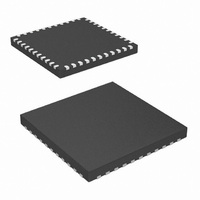PIC18F47J13-I/ML Microchip Technology, PIC18F47J13-I/ML Datasheet - Page 266

PIC18F47J13-I/ML
Manufacturer Part Number
PIC18F47J13-I/ML
Description
IC PIC MCU 128KB FLASH 44QFN
Manufacturer
Microchip Technology
Series
PIC® XLP™ 18Fr
Datasheets
1.PIC18LF24J10-ISS.pdf
(32 pages)
2.PIC18F26J13-ISS.pdf
(496 pages)
3.PIC18F26J13-ISS.pdf
(558 pages)
4.PIC18F26J13-ISS.pdf
(12 pages)
Specifications of PIC18F47J13-I/ML
Core Size
8-Bit
Program Memory Size
128KB (64K x 16)
Core Processor
PIC
Speed
48MHz
Connectivity
I²C, LIN, SPI, UART/USART
Peripherals
Brown-out Detect/Reset, POR, PWM, WDT
Number Of I /o
34
Program Memory Type
FLASH
Ram Size
3.8K x 8
Voltage - Supply (vcc/vdd)
2.15 V ~ 3.6 V
Data Converters
A/D 13x10b/12b
Oscillator Type
Internal
Operating Temperature
-40°C ~ 85°C
Package / Case
*
Controller Family/series
PIC18
Cpu Speed
48MHz
Digital Ic Case Style
QFN
Supply Voltage Range
1.8V To 5.5V
Embedded Interface Type
I2C, SPI, USART
Rohs Compliant
Yes
Processor Series
PIC18F
Core
PIC
Data Bus Width
8 bit
Data Ram Size
4 KB
Interface Type
I2C, SPI, EUSART
Maximum Clock Frequency
48 MHz
Number Of Programmable I/os
25
Number Of Timers
8
Operating Supply Voltage
2 V to 3.6 V
Maximum Operating Temperature
+ 85 C
Mounting Style
SMD/SMT
3rd Party Development Tools
52715-96, 52716-328, 52717-734, 52712-325, EWPIC18
Development Tools By Supplier
DM164128, DM180021, DM183026-2, DV164131, MA180030, DM183022, DM183032, DV164136, MA180024
Minimum Operating Temperature
- 40 C
On-chip Adc
12 bit, 13 Channel
Lead Free Status / RoHS Status
Lead free / RoHS Compliant
For Use With
MA180030 - BOARD DEMO PIC18F47J13 FS USBMA180029 - BOARD DEMO PIC18F47J53 FS USB
Eeprom Size
-
Lead Free Status / Rohs Status
Details
- PIC18LF24J10-ISS PDF datasheet
- PIC18F26J13-ISS PDF datasheet #2
- PIC18F26J13-ISS PDF datasheet #3
- PIC18F26J13-ISS PDF datasheet #4
- Current page: 266 of 558
- Download datasheet (5Mb)
PIC18F47J13 FAMILY
18.4
In Pulse-Width Modulation (PWM) mode, the CCP4 pin
produces up to a 10-bit resolution PWM output. Since
the CCP4 pin is multiplexed with a PORTB data latch,
the appropriate TRISx bit must be cleared to make the
CCP4 pin an output.
Figure 18-3 shows a simplified block diagram of the
CCP1 module in PWM mode.
For a step-by-step procedure on how to set up the CCP
module for PWM operation, see Section 18.4.3
“Setup for PWM Operation”.
FIGURE 18-3:
DS39974A-page 266
Note 1:
CCPR4H (Slave)
Duty Cycle Registers
Comparator
CCPR4L
2:
TMR2
PR2
Comparator
PWM Mode
The 8-bit TMR2 value is concatenated with the 2-bit
internal Q clock, or 2 bits of the prescaler, to create
the 10-bit time base.
CCP4 and its appropriate timers are used as an
example. For details on all of the CCP modules and
their timer assignments, see Table 18-2 and
Table 18-3.
(Note 1)
Clear Timer,
CCP1 pin and
latch D.C.
SIMPLIFIED PWM BLOCK
DIAGRAM
CCP4CON<5:4>
R
S
(2)
Q
TRISC<2>
RC2
Preliminary
A PWM output (Figure 18-4) has a time base (period)
and a time that the output stays high (duty cycle). The
frequency of the PWM is the inverse of the period
(1/period).
FIGURE 18-4:
18.4.1
The PWM period is specified by writing to the PR2
register. The PWM period can be calculated using the
following formula:
EQUATION 18-1:
PWM frequency is defined as 1/[PWM period].
When TMR2 is equal to PR2, the following three events
occur on the next increment cycle:
• TMR2 is cleared
• The CCP4 pin is set
• The PWM duty cycle is latched from CCPR4L into
(An exception: If the PWM duty cycle = 0%, the
CCP4 pin will not be set)
CCPR4H
Note:
PWM Period = [(PR2) + 1] • 4 • T
TMR2 = PR2
Duty Cycle
PWM PERIOD
The Timer2 postscalers (see Section 14.0
“Timer2 Module”) are not used in the
determination of the PWM frequency. The
postscaler could be used to have a servo
update rate at a different frequency than
the PWM output.
Period
TMR2 = Duty Cycle
(TMR2 Prescale Value)
PWM OUTPUT
2010 Microchip Technology Inc.
TMR2 = PR2
OSC
•
Related parts for PIC18F47J13-I/ML
Image
Part Number
Description
Manufacturer
Datasheet
Request
R

Part Number:
Description:
Manufacturer:
Microchip Technology Inc.
Datasheet:

Part Number:
Description:
Manufacturer:
Microchip Technology Inc.
Datasheet:

Part Number:
Description:
Manufacturer:
Microchip Technology Inc.
Datasheet:

Part Number:
Description:
Manufacturer:
Microchip Technology Inc.
Datasheet:

Part Number:
Description:
Manufacturer:
Microchip Technology Inc.
Datasheet:

Part Number:
Description:
Manufacturer:
Microchip Technology Inc.
Datasheet:

Part Number:
Description:
Manufacturer:
Microchip Technology Inc.
Datasheet:

Part Number:
Description:
Manufacturer:
Microchip Technology Inc.
Datasheet:










